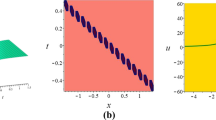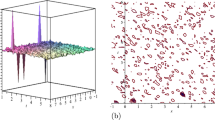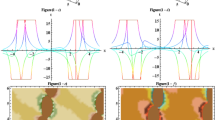Abstract
In this article, the propagation of pulses in optical fiber has been studied by considering the nonlinear partial differential equation (NPDE). The proposed model is investigated using two analytical techniques namely the Sine-Gordon expansion (SGE) procedure and the modified auxiliary equation (MAE) method. The trigonometric function, hyperbolic function, and rational function solutions have been extracted from the proposed methods. The employed procedures are compatible in obtaining traveling wave solutions. Moreover, the obtained results are assisted with 3D graphs to demonstrate the physical significance and dynamical behaviors by using different parameter values.
Similar content being viewed by others
Avoid common mistakes on your manuscript.
1 Introduction
Within the past few years, exact solutions of NPDEs have gained considerable attention. For this reason many distinct procedures have utilized by researchers. We can list some of them as follows. Wazwaz have derived periodic soliton solutions of the Dodd-Bullough-Mikhailov and the Tzitzeica-Dodd-Bullough equations by tanh technique Wazwaz (2005). Akbulut et al. employed the modified simple equation method to the the fifth-order KdV equation Akbulut et al. (2021a) and verified trivial conservation laws and solitary wave solutions for the fifth order Lax equation Akbulut et al. (2021b). Akinyemi et al. have implemented the improved Sardar sub-equation method to the perturbed nonlinear Schrödinger-Hirota equation with spatio-temporal dispersion Akinyemi et al. (2021). Aksoy et al. utilized the exponential rational function method for space–time fractional differential equations Aksoy et al. (2016). Ma et al. have considered the Hirota-Maccari system via the first integral procedure to extract bright, singular, and dark soliton solutions Ma et al. (2021). Sun et al. have utilized the Hirota bilinear technique to the (2+1)-dimensional B-Kadomtsev-Petviashvili equation to find M-lump solutions Sun et al. (2022). Durur et al. sub-equation procedure to the KdV6 equation Durur et al. (2020). Hosseini et al. have analyzed soliton solutions of the Hirota-Satsuma-Ito equation via the linear superposition principle Hosseini et al. (2021). Raza et al. have applied the Painleve approach to a nonlinear Kudryashov’s equation Raza et al. (2021). Kumar have founded travelling waves, kink waves, rational function, lump-type solitons, multi-solitons, hyperbolic function, and trigonometric solutions by generalised exponential rational function method Kumar (2021). Osman et al. verified some travelling wave solutions of the 2D-chiral nonlinear Schrodinger equation Osman et al. (2020). Inc et al. have founded exact analytic solutions for the (2+1)-dimensional Ito equation by using simplest equation technique Inc et al. (2021). Akbulut et al. obtained the conservation laws of time fractional modified Korteweg–de Vries (mkdv) equation Akbulut and Tascan (2017a), searched some soliton solutions for various equations Akbulut et al. (2022), and applied conservation theorem and modified extended tanh-function procedure to nonlinear coupled Klein–Gordon–Zakharov equation Akbulut and Tascan (2017b). Mirzazadeh et al. employed the improved F-expansion method to find different wave solutions Mirzazadeh et al. (2022). Hosseini et al. obtained conservation laws and kink solitons of the Sharma–Tasso–Olver–Burgers equation Hosseini et al. (2022). In this paper, to explain the propagation pulse in optical fiber, we are considering a new NPDE, in the following form
In Eq. (1), the complex function f(x, t) representing optical wave, where m and n are usually rational numbers (not necessarily integers) \(\alpha _1\) , \(\beta _1\) , \(\gamma _1\), and \(\lambda _1\) are the parameters. Equation (1) is the generalization of the well known nonlinear Schrödinger equation. At \(m=0\) Eq. (1) get the following form
The motivation of this paper is to study Eq. (1). For investigating Eq. (1), two partial differential equations have been obtained from Eq. (1) by taking \(m=n\) and \(m=2n\). Upon putting \(m=n\), Eq. (1) becomes
and when we consider \(m=2n\), we obtain the equation with polynomial nonlinearity in the following expression
The paper consists of the following sections: We presented the mathematical analysis of the considered model in Sect. 2. Then, we gave a description of utilized techniques, respectively the SGE and the MAE techniques in Sect. 3. The extraction of soliton solutions for the proposed models was given in Sect. 4. Section 5 gives graphical illustrations of the obtained results. Finally, the conclusion of the whole research in Sect. 6.
2 The mathematical analysis
In order to find the exact soliton solution of Eqs. (3) and (4), the following traveling wave transformation is considered, as
where c is the speed and \(\Upsilon \) is the amplitude of traveling wave. Using the transformation Eq. (5), the real parts of Eqs. (3) and (4) have been transformed into following ODEs, respectively as,
and
The imaginary parts of Eqs. (3) and (4) gives the speed of traveling wave as
In order to obtain the closed form solutions for Eq. (6), apply the following transformation
Eq. (6) takes the following form
For obtaining closed form solutions for Eq. (10), the constraint conditions \(\beta _1=\delta _1=0\) have been imposed. Equation (10) becomes
In order to obtain the closed form solutions for Eq. (7), apply the following transformation
Eq. (7) takes the following form
For obtaining closed form solutions for Eq. (13), the constraint conditions \(\alpha _1=\gamma _1=\delta _1=0\) have been imposed. Equation (13) becomes
3 Description of utilized techniques
In this section, we gave a description of utilized techniques, SGE Alquran and Krishnan (2016)- Inc et al. (2018) and MAE Khater et al. (2019) respectively.
3.1 The Sine-Gordon expansion method
We take into consideration:
where \(f=f(x,t)\) and \(a\ne 0\).
Then, we apply the traveling wave transformation Eqs. (5), (15) reduces to
Integrating the above equation gives,
Here X is an integration constant. If we set \(X=0\), \(\frac{F}{2}=\vartheta (\Upsilon )\) and \(h^{2}=\frac{a^{2}}{1-c^{2}}\), then Eq. (17) becomes
If we take \(h=1\) in Eq. (18), then we find
Afterwards, we solve Eq. (19) to find
We predict the solution as follows:
Using Eqs. (20), (21), (22) becomes
Here N is the balancing number, which will be determined according to the homogenous balance technique. Then, we insert Eq. (23) into ODE to find an equation system for \(A_{0}\), \(A_{i}\), \(B_{i}\). This system is founded if we equate the coefficients of each power of \(\sin ^{p}(\vartheta ) \cos ^{q}(\vartheta )\) to zero. Solving the resulting system for \(A_{0}\), \(A_{i}\), \(B_{i}\).
3.2 Modified auxiliary equation (MAE) method
According to MAE method the solution of transformed ODE has the following form
\(p_0\), \(q_{k}\) and \(r_{k}\) are constants. \(G(\Upsilon )\) satisfies the differential equation
\(\beta \), \(\alpha \), \(\sigma \) are constants along with \(w>0\) and \(w\ne 1\). The differential equation (25) has three types of solutions which are given below
Type 1:
When \(\beta ^{2}-4\alpha \sigma <0\) and \(\sigma \ne 0\) then
or
Type 2:
When \(\beta ^{2}-4\alpha \sigma >0\) and \(\sigma \ne 0\) then
or
Type 3:
When \(\beta ^{2}-4\alpha \sigma =0\) and \(\sigma \ne 0\) then
4 Construction of solutions using proposed methods
This section gives the extraction of soliton solutions for the proposed models Eqs. (3) and (4) by employing the most efficient analytical procedures, SGE and the MAE techniques.
4.1 Method-I (SGE) method
In this subsection, we will obtain soliton solutions of Eqs. (3) and (4) via the SGE procedure. For this purpose, we balance \(V'^2\) with \(V^{4}\) in Eq. (11) and find \(N=1\). Therefore, the solution takes the form:
Then, we use the solution procedure as explained earlier in Sect. 3. The values of unknowns \(A_{0}\), \(A_{1}\), \(B_{1}\) are calculated as:
SET 1:
SET 2
SET 3
Bright-dark soliton solutions can be founded for SET 1 as
Bright soliton solutions can be founded for SET 2 as follows
Dark soliton solutions are obtained for SET 3 as follows
Moreover, we will also find soliton solutions of Eq. (4) via SGE technique. If we balance \(V'^2\) with \(V^{4}\) in Eq. (14), we find as \(N=1\). The values of unknowns \(A_{0}\), \(A_{1}\), \(B_{1}\) are calculated as:
SET 1:
Dark soliton solutions can be founded for SET 1 as
4.2 Method-II (MAE) technique
In this subsection, we will find soliton solutions of Eq. (3) via MAE technique. Since N is founded as 1, Eq. (24) takes the following form
where \(p_0, q_1\) and \(r_1\) are constants to be determined by Inserting Eq. (31) in the Eq. (11). Then assemble all the coefficients of the powers of \(w^{G(\xi )}\) and put them equal to zero. This leads to construction of set of algebraic equations. Upon solving the obtained system gives the value of arbitrary parameters \(p_0, q_{1}\) and \(r_{1}\), which are summarized in the following sets of solutions as
SET 1:
SET 2:
The solutions corresponding to SET 1: are evaluated below.
Type 2:
When \(\beta ^{2}-4\alpha \sigma >0\) and \(\sigma \ne 0\) then
or
The solutions corresponding to SET 2: are evaluated below.
Type 1:
When \(\beta ^{2}-4\alpha \sigma <0\) and \(\sigma \ne 0\) then
or
Type 2:
When \(\beta ^{2}-4\alpha \sigma >0\) and \(\sigma \ne 0\) then
or
We wil find soliton solutions of Eq. (4) via MAE procedure.
SET 1:
SET 2:
The solutions corresponding to SET 1: are evaluated below.
Type 2:
When \(\beta ^{2}-4\alpha \sigma >0\) and \(\sigma \ne 0\) then
or
The solutions corresponding to SET 2: are evaluated below.
Type 1:
When \(\beta ^{2}-4\alpha \sigma <0\) and \(\sigma \ne 0\) then
or
Type 2:
When \(\beta ^{2}-4\alpha \sigma >0\) and \(\sigma \ne 0\) then
or
5 Graphical illustrations
In this section, we provide the graphical illustrations of few of the determined solutions. It is important to mention here that explicit and consistent wave solutions are extracted by applying two different reliable schemes. Figures 1, 2, 3 and 4 represents the 3D and 2D plots of Eqs. (29), (30), (35) and (44) respectively by taking \(\gamma _1=2\), \(k=1\), \(w=2\), \(\alpha =1\), \(\sigma =1\) and \(\beta _1=2\).
6 Conclusion
In this work, the trigonometric function solutions, hyperbolic function solutions, and rational function solutions have been analyzed to investigate the propagation of pulses in optical fiber. These results are beneficial and useful in optical fibers and nonlinear wave phenomena. We have successfully implemented the SGE and the MAE technique with the help of computerized symbolic computation. The outcomes of the present manuscript affirmed the capacity of the schemes in handling a broad diverseness of NPDEs. Moreover, for future works, super nonlinear, quasi-periodic, chaotic, and solitonic waves can be founded.
References
Akbulut, A., Tascan, F.: Trivial conservation laws and solitary wave solution of the fifth order Lax equation. Chaos Solitons Fractals 100, 1–6 (2017a)
Akbulut, A., Tascan, F.: Application of conservation theorem and modified extended tanh-function method to (1+1)-dimensional nonlinear coupled Klein-Gordon-Zakharov equation. Chaos Solitons Fractals 104, 33–40 (2017b)
Akbulut, A., Kaplan, M., Kaabar, M.K.A.: New conservation laws and exact solutions of the special case of the fifth-order KdV equation. J. Ocean Eng. Sci. (2021a). https://doi.org/10.1016/j.joes.2021.09.010
Akbulut, A., Tascan, F., Ozel, E.: Trivial conservation laws and solitary wave solution of the fifth order Lax equation. Partial Differ. Equ. Appl. Math. 4, 100101 (2021b)
Akbulut, A., Islam, S.R., Rezazadeh, H., Tascan, F.: Obtaining exact solutions of nonlinear partial differential equations via two different methods. Int. J. Mod. Phys. B 36(05), 2250041 (2022)
Akinyemi, L., Rezazadeh, H., Shi, Q.H., Inc, M., Khater, M.M.A., Ahmad, H., Jhangeer, A., Akbar, M.A.: New optical solitons of perturbed nonlinear Schrodinger-Hirota equation with spatio-temporal dispersion. Res. Phys. 29(7), 104656 (2021)
Aksoy, E., Kaplan, M., Bekir, A.: Exponential rational function method for space-time fractional differential equations. Waves Random Complex Media 262, 142–151 (2016)
Alquran, M., Krishnan, E.V.: Applications of sine-Gordon expansion method for a reliable treatment of some nonlinear wave equations. Nonlinear Stud. 23(4), 639–649 (2016)
Durur, H., Kurt, A., Tasbozan, O.: New travelling wave solutions for KdV6 equation using sub equation method. Appl. Math. Nonlinear Sci. 5(1), 455–460 (2020)
Hosseini, K., Pouyanmehr, R., Ansari, R.: Multiple complex and real soliton solutions to the new integrable (2+1) dimensional Hirota-Satsuma-Ito equation. Comput. Sci. Eng. 1(2), 91–97 (2021)
Hosseini, K., Akbulut, A., Baleanu, D., Salahshour, S.: The Sharma-Tasso-Olver-Burgers equation: its conservation laws and kink solitons. Commun. Theor. Phys. 74, 025001 (2022)
Inc, M., Aliyu, A.I., Yusuf, A., Baleanu, D.: Optical solitons for Biswas-Milovic model in nonlinear optics by sine-Gordon equation method. Optik 157, 267–274 (2018)
Inc, M., Az-Zo’bi, E.A., Jhangeer, A., Rezazadeh, H., Ali, M.N., Kaabar, M.K.A.: New soliton solutions for the higher-dimensional non-local Ito Eequation. Nonlinear Eng. 10, 374–384 (2021)
Khater, M., Attia, R.A.M., Lu, D.: Modified auxiliary equation method versus three nonlinear fractional biological models in present explicit wave solutions. Math. Comput. Appl. 24(1), 1 (2019)
Kumar, S.: Some new families of exact solitary wave solutions of the Klein-Gordon-Zakharov equations in plasma physics. Pramana 95, 1–15 (2021)
Ma, W.X., Osman, M.S., Arshed, S., Raza, N., Srivastava, H.M.: Practical analytical approaches for finding novel optical solitons in the single-mode fibers. Chin. J. Phys. 72, 475–486 (2021)
Mirzazadeh, M., Akbulut, A., Tascan, F., Akinyemi, L.: A novel integration approach to study the perturbed Biswas-Milovic equation with Kudryashov’s law of refractive index. Optik 252, 168529 (2022)
Osman, M.S., Baleanu, D., Tariq, K. Ul-Haq., Kaplan, M., Younis, M., Rizvi, S.T.R.: Different types of progressive wave solutions via the 2D-chiral nonlinear Schrödinger equation. Front. Phys. 8, 215 (2020)
Raza, N., Seadawy, A.R., Kaplan, M., Butt, A.R.: Symbolic computation and sensitivity analysis of nonlinear Kudryashovs dynamical equation with applications. Phys. Scr. 96, 105216 (2021)
Sun, Y.L., Chen, J., Ma, W.X., Yu, J.P., Khalique, C.M.: Further study of the localized solutions of the (2+1)-dimensional B-Kadomtsev-Petviashvili equation. Commun. Nonlinear Sci. Numer. Simul. 107, 106131 (2022)
Wazwaz, A.M.: The tanh method: solitons and periodic solutions for the Dodd-Bullough-Mikhailov and the Tzitzeica-Dodd-Bullough equations. Chaos Solitons Fractals 25(1), 55–63 (2005)
Yasar, E., Yildirim, Y., Yasar, E.: New optical solitons of space time conformable fractional perturbed Gerdjikov-Ivanov equation by sine-Gordon equation method. Res. Phys. 9, 1666–1672 (2018)
Funding
The authors have not disclosed any funding.
Author information
Authors and Affiliations
Corresponding author
Ethics declarations
Conflict of interest
The authors have not disclosed any competing interests.
Additional information
Publisher's Note
Springer Nature remains neutral with regard to jurisdictional claims in published maps and institutional affiliations.
Rights and permissions
About this article
Cite this article
Raza, N., Arshed, S., Kaplan, M. et al. An exploration of novel soliton solutions for propagation of pulses in an optical fiber. Opt Quant Electron 54, 462 (2022). https://doi.org/10.1007/s11082-022-03861-y
Received:
Accepted:
Published:
DOI: https://doi.org/10.1007/s11082-022-03861-y








